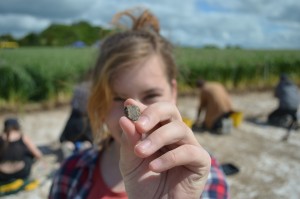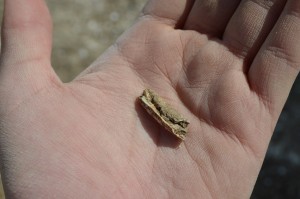Once everyone had arrived at the site a brief talk was given by the Site Directors, Miles Russell and Paul Cheetham. During this they highlighted the importance of ‘cleaning back’ the trenches as a precursor to excavation, a process which involves trowelling back the trench surface which aids a preliminary identification of features while defining their extent. The site directors anticipated this task would be completed by the end of the day, so that the excavation of features can begin on Wednesday 10th June.
Trench A Director Harry Manley supervised the students ‘cleaning back’ using trowels only. In contrast the students in Trench B (superintended by Derek Pitman) were permitted to use brushes to aid the clearance of dust from the chalk in conjunction with trowel use. This addition of this technique resulted in much clearer definition between the features and geology when compared with trowel use only; it proved to be more efficient in the very dry conditions of the trench. However, the application of this technique is inappropriate for wet and damp conditions, and is only to be used at the discretion of the Trench Director where there is minimal risk to the integrity of the archaeological remains.
Within Trench A, finds in the form of artefacts and remains were surfacing, due to their displacement caused by ploughing of the soil. Ceramics, including possible Black Burnished Ware and some originating within the Bronze Age were discovered alongside faunal remains such as what had initially been identified as the tooth of a sheep, the distal end of a femur (possibly cow) and a small unidentified fragment of bone. Traces of burnt flint and clay were also recovered, suggesting perhaps that areas of the Trench may have possibly been utilised as a settlement, which would form the missing link within the record of the transition from prehistory to history in Dorset. The initial definition of the smaller features also took place in order to gain a better understanding of their size and nature. A second large circular feature was discovered within Trench B, once the top soil had been removed, inferring the possible presence of a second round house. The presence of post holes within the parameters of the feature also strongly supported the interpretation that the structure existed as part of a settlement.
Meanwhile, it is hoped that Environmental sampling will begin on Wednesday 10th June. This aspect of the investigation is being overseen by Laura Germain, Amy Potts and Richard Smith. In preparation, the flotation and dry sieving equipment have been set up; for health and safety reasons the flotation tank had to be level and the generator positioned away from the crop which is flammable. They also sorted the arrears of the previous season while endeavouring to correct any mistakes in the existing record. Such mistakes could otherwise limit the credibility of the archaeological record of the excavation while also limiting the accuracy of the interpretations inferred.
What does environmental sampling involve?
Environmental sampling can inform an impression of the environment and economy from which the sample dates. Samples of the matrix of archaeological contexts are acquired by the excavator. There are three components of an environmental sample which are the sub sample, dry sieving sample and the flotation sample. These processes are designed with the intention of gathering bone, ceramic, seeds, snails, charcoal and chipped stone, all of which can be analysed as part of post excavation. Flotation is the method of extracting organic materials from a sample. The sample must first be cleaned in the mesh prior to the activation of the flotation pump. This ensures that the sample is free from any inclusions that may hinder microscopy and chemical analysis. Once the flotation pump is activated, the water level increases and the organic material in the mesh floats and is deposited into a sieve. When complete the sample is dried, and bagged with according labelling.
Michael Osborn, a student on placement, conducted a prospective survey of the spoil heaps and trenches using a xp Deus metal detector. This detector can indicate the presence of ferrous, non-ferrous metals including copper and the magnetic mineralisation that occurs in as a result of high temperature industries, including materials such as hearth, pot and slag (within a range of 4kHz to 18kHz). Prospection of the spoil heaps yielded a number of Roman nails. It is most likely that these nails have been dragged from their location of deposition by ploughing, hence their location in the topsoil. Alternatively, if these nails are associated with the (prospective) Iron Age settlement it could reflect the integration of Roman technology into a stylistically Iron Age/Durotrigan features such as roundhouses; could the incorporation of Roman technology, to aid functionality, reflect any aspect of the reception of the Romans by the Durotrigans?

